- Accueil
- Pages cachées
- 28 JANVIER 2024 NEWS
28 JANVIER 2024 NEWS
INSTITUT SUPERIEUR D'ANTHROPOLOGIE
INSTITUTE OF ANTHROPOLOGY
ONLINE COURSES / COURS A DISTANCE
INSCRIPTIONS OUVERTES
REGISTER NOW
GRECE - 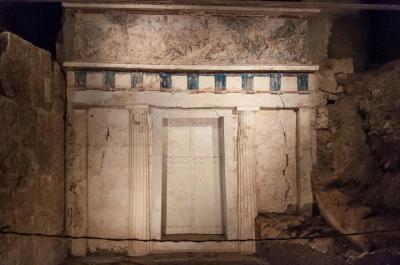
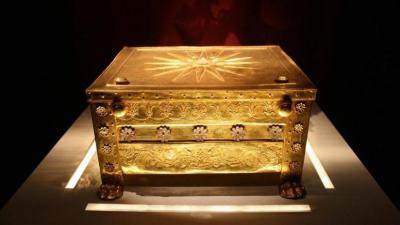 Vergina - The identities of the occupants of the unspoiled 4th-century BCE Royal Tombs at Vergina in northern Greece have been identified. The burials contain the remains of Alexander’s father, stepmother, half-siblings, and son, along with armor and other items belonging to the man himself. While there is never been any doubt that the human skeletal remains found in Royal Tombs I, II, and III belong to close relatives of Alexander, scholars have spent almost half a century bickering over who exactly lies within each grave. The researchers examined the skeletal elements with the aid of macrophotography, radiographs, and anatomical dissection. The study authors combined osteological analyses, macro photography, X-rays, and anatomical dissections of the ancient remains with historical sources from the ancient past. A knee fusion was found in the male skeleton of Tomb I consistent with the historic evidence of the lameness of King Philip II. Researchers also discovered that Tomb I contained the bones of a man with an injured knee, as well as a woman and a baby, who was just days or weeks old at the time of death. They conclude that the male figure was Alexander the Great’s father, King Philip II of Macedon, who was known to limp. The infant’s extremely young age is also consistent with the story of Philip’s assassination in 336 BCE. According to most sources, Philip II was assassinated by his bodyguard only a few days after his wife Cleopatra gave birth. The murder is thought to have been ordered by Philip’s previous wife, Olympias, the mother of Alexander the Great. Almost immediately after the assassination, Olympias killed Cleopatra and her baby, possibly by burning them alive, paving the way for Alexander to succeed to the throne. Previously, some scholars claimed that Philip II was buried in Tomb II, which also houses the remains of a man and a woman. However, the absence of a baby, combined with no obvious signs of physical trauma on the male skeleton, eliminates this possibility. Researchers concluded that Tomb II belonged to the “warrior woman” Adea Eurydice, wife of Alexander’s half-brother King Arrhidaeus. They reached this conclusion based on skeletal evidence for excessive horseback riding. “Due to ancient depictions and descriptions, some scholars have suggested that some of the objects in Tomb II, such as the armor, belonged to Alexander the Great, which is possible only if this is the Tomb of Arrhidaeus, not Philip II,” write the authors. Thus, these remains are determined to be those of “Alexander’s much less impressive brother” and his rather impressive warrior wife. Sources hint that this was an unequal marriage because the king was disabled mentally. The evidence presented supports the conclusion that Tomb I belongs to King Philip II, his wife Cleopatra, and their newborn child. Tomb II belongs to King Arrhidaeus and his wife Adea Eurydice. Lastly, the study’s authors discover no evidence to challenge the widely held belief that Alexander IV, Alexander the Great’s teenage son, is buried in Tomb III.
Vergina - The identities of the occupants of the unspoiled 4th-century BCE Royal Tombs at Vergina in northern Greece have been identified. The burials contain the remains of Alexander’s father, stepmother, half-siblings, and son, along with armor and other items belonging to the man himself. While there is never been any doubt that the human skeletal remains found in Royal Tombs I, II, and III belong to close relatives of Alexander, scholars have spent almost half a century bickering over who exactly lies within each grave. The researchers examined the skeletal elements with the aid of macrophotography, radiographs, and anatomical dissection. The study authors combined osteological analyses, macro photography, X-rays, and anatomical dissections of the ancient remains with historical sources from the ancient past. A knee fusion was found in the male skeleton of Tomb I consistent with the historic evidence of the lameness of King Philip II. Researchers also discovered that Tomb I contained the bones of a man with an injured knee, as well as a woman and a baby, who was just days or weeks old at the time of death. They conclude that the male figure was Alexander the Great’s father, King Philip II of Macedon, who was known to limp. The infant’s extremely young age is also consistent with the story of Philip’s assassination in 336 BCE. According to most sources, Philip II was assassinated by his bodyguard only a few days after his wife Cleopatra gave birth. The murder is thought to have been ordered by Philip’s previous wife, Olympias, the mother of Alexander the Great. Almost immediately after the assassination, Olympias killed Cleopatra and her baby, possibly by burning them alive, paving the way for Alexander to succeed to the throne. Previously, some scholars claimed that Philip II was buried in Tomb II, which also houses the remains of a man and a woman. However, the absence of a baby, combined with no obvious signs of physical trauma on the male skeleton, eliminates this possibility. Researchers concluded that Tomb II belonged to the “warrior woman” Adea Eurydice, wife of Alexander’s half-brother King Arrhidaeus. They reached this conclusion based on skeletal evidence for excessive horseback riding. “Due to ancient depictions and descriptions, some scholars have suggested that some of the objects in Tomb II, such as the armor, belonged to Alexander the Great, which is possible only if this is the Tomb of Arrhidaeus, not Philip II,” write the authors. Thus, these remains are determined to be those of “Alexander’s much less impressive brother” and his rather impressive warrior wife. Sources hint that this was an unequal marriage because the king was disabled mentally. The evidence presented supports the conclusion that Tomb I belongs to King Philip II, his wife Cleopatra, and their newborn child. Tomb II belongs to King Arrhidaeus and his wife Adea Eurydice. Lastly, the study’s authors discover no evidence to challenge the widely held belief that Alexander IV, Alexander the Great’s teenage son, is buried in Tomb III.
ALLEMAGNE – 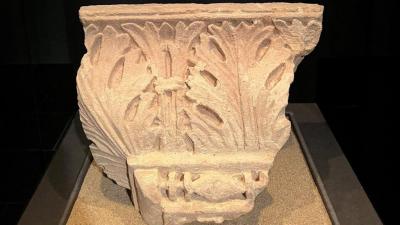 Cologne - An area of around 4,000 square meters (43,055 square feet) is being discovered beneath the Cologne Cathedral, the largest Gothic church in northern Europe. Excavations under the monumental building began in 1946. Since then, the abundance of finds has grown into a sea of contemporary evidence. The first archaeological excavations inside the cathedral began under the direction of Otto Doppelfeld. They were continued over decades and continue in individual projects to this day. As a result of this work, rooms were created below the cathedral, which now extend under almost all areas of the current church floor and cover an area of around 4,000 square meters. This means that the Cologne Cathedral excavation is not only one of the most extensive church excavations in Germany, but it can also be visited on guided tours. In the course of the archaeological investigations, floor plans and internal structures of various older buildings were uncovered, among which not only the Old Cathedral, which has also been handed down historically but also other previous buildings deserve special mention. Together with numerous architectural remains and an immense number of archaeological finds, around 260,000, they testify to the development from an upscale Roman city quarter to the Christian center of Cologne and, with a view of the huge foundations of the Gothic cathedral, also provide an impression of the effort and process of its creation. “We’ve uncovered a huge area here and worked our way back to the ancient Roman period,” says archaeologist Ruth Stinnesbeck, with an area of around 4,000 square meters (43,055 square feet) under the famous church being explored. Originally, the current archaeology team wanted to learn more about an older cathedral building from the 8th and 9th centuries that no longer existed. Historical records told them it had once stood in that exact spot—and had an important significance. Charlemagne, the Frankish king who later became Holy Roman Emperor, appointed his close friend and advisor Hildebold as the first archbishop of Cologne around 795. To commemorate the appointment, he constructed a Romanesque-style cathedral on the site of a baptistery that had already existed for two centuries. Although it was nowhere near the size of the Cologne Cathedral, which is one of the largest churches in the world, the former building was by no means small, confirms Stinnesbeck. “It was almost 100 meters (328 ft) long, which was very significant 1,200 years ago — that’s two-thirds the size of today’s cathedral,” she says. Archaeologists discovered not only Hildebold’s building, but also much older historical finds from Roman times. Cologne’s Roman period lasted from the first century BC to the mid-5th century AD, or approximately 500 years. Originally, present-day Cologne was just a Roman colony for wealthy families in the Rhineland called Colonia Claudia Ara Agrippinensium. The remains of their luxurious villas, including murals and traces of an underfloor heating system, are currently being excavated beneath the cathedral.
Cologne - An area of around 4,000 square meters (43,055 square feet) is being discovered beneath the Cologne Cathedral, the largest Gothic church in northern Europe. Excavations under the monumental building began in 1946. Since then, the abundance of finds has grown into a sea of contemporary evidence. The first archaeological excavations inside the cathedral began under the direction of Otto Doppelfeld. They were continued over decades and continue in individual projects to this day. As a result of this work, rooms were created below the cathedral, which now extend under almost all areas of the current church floor and cover an area of around 4,000 square meters. This means that the Cologne Cathedral excavation is not only one of the most extensive church excavations in Germany, but it can also be visited on guided tours. In the course of the archaeological investigations, floor plans and internal structures of various older buildings were uncovered, among which not only the Old Cathedral, which has also been handed down historically but also other previous buildings deserve special mention. Together with numerous architectural remains and an immense number of archaeological finds, around 260,000, they testify to the development from an upscale Roman city quarter to the Christian center of Cologne and, with a view of the huge foundations of the Gothic cathedral, also provide an impression of the effort and process of its creation. “We’ve uncovered a huge area here and worked our way back to the ancient Roman period,” says archaeologist Ruth Stinnesbeck, with an area of around 4,000 square meters (43,055 square feet) under the famous church being explored. Originally, the current archaeology team wanted to learn more about an older cathedral building from the 8th and 9th centuries that no longer existed. Historical records told them it had once stood in that exact spot—and had an important significance. Charlemagne, the Frankish king who later became Holy Roman Emperor, appointed his close friend and advisor Hildebold as the first archbishop of Cologne around 795. To commemorate the appointment, he constructed a Romanesque-style cathedral on the site of a baptistery that had already existed for two centuries. Although it was nowhere near the size of the Cologne Cathedral, which is one of the largest churches in the world, the former building was by no means small, confirms Stinnesbeck. “It was almost 100 meters (328 ft) long, which was very significant 1,200 years ago — that’s two-thirds the size of today’s cathedral,” she says. Archaeologists discovered not only Hildebold’s building, but also much older historical finds from Roman times. Cologne’s Roman period lasted from the first century BC to the mid-5th century AD, or approximately 500 years. Originally, present-day Cologne was just a Roman colony for wealthy families in the Rhineland called Colonia Claudia Ara Agrippinensium. The remains of their luxurious villas, including murals and traces of an underfloor heating system, are currently being excavated beneath the cathedral.
https://arkeonews.net/hidden-archaeological-treasures-from-cologne-cathedral/
USA – 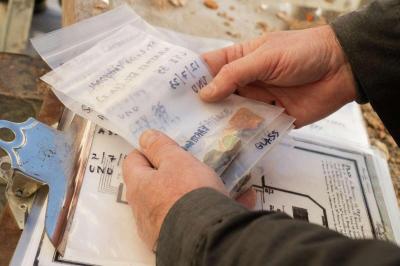 New Orleans - There's no denying the rich history and culture of New Orleans and the St. Louis Cathedral located in the French Quarter, a place of worship that sits on one of the oldest church sites in North America, dating back to the 18th century. A research team from the University of New Orleans went underground to explore the 300-year-old foundation of the church. Gray, who specializes in urban historical archaeology in the city, and a team of archeologists excavated two six-foot-deep pits to examine the cathedral's foundation as part of a planned restoration project, according to the University of New Orleans. The excavation determined the foundation dates back to 1724-1727 when the St. Louis Church was first built Archaeologists discovered French and Native American pottery, glass, clay-smoking pipe fragments, a fish bone, part of a religious medallion, a bead, and nails. In addition, the research team found a copious amount of straight pins in the foundation's layers. Gray believes the pins were used to hold curtains and fabric in place during the 1720s when the church was first built since window panes were unavailable, the University of New Orleans stated. When the excavations were examined, the stratigraphy determined that the various layers contained a record of the entire 18th-century church history. The team's work revealed renovations to that first church, evidence of the 1788 fire, the cathedral's reconstruction in 1794 and its expansion into the present version in 1849.
New Orleans - There's no denying the rich history and culture of New Orleans and the St. Louis Cathedral located in the French Quarter, a place of worship that sits on one of the oldest church sites in North America, dating back to the 18th century. A research team from the University of New Orleans went underground to explore the 300-year-old foundation of the church. Gray, who specializes in urban historical archaeology in the city, and a team of archeologists excavated two six-foot-deep pits to examine the cathedral's foundation as part of a planned restoration project, according to the University of New Orleans. The excavation determined the foundation dates back to 1724-1727 when the St. Louis Church was first built Archaeologists discovered French and Native American pottery, glass, clay-smoking pipe fragments, a fish bone, part of a religious medallion, a bead, and nails. In addition, the research team found a copious amount of straight pins in the foundation's layers. Gray believes the pins were used to hold curtains and fabric in place during the 1720s when the church was first built since window panes were unavailable, the University of New Orleans stated. When the excavations were examined, the stratigraphy determined that the various layers contained a record of the entire 18th-century church history. The team's work revealed renovations to that first church, evidence of the 1788 fire, the cathedral's reconstruction in 1794 and its expansion into the present version in 1849.
https://www.beaumontenterprise.com/news/article/st-louis-cathedral-excavation-18625429.php
GRECE - 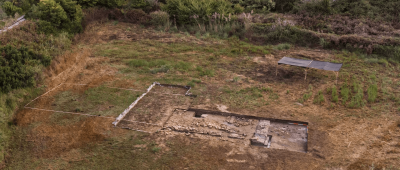
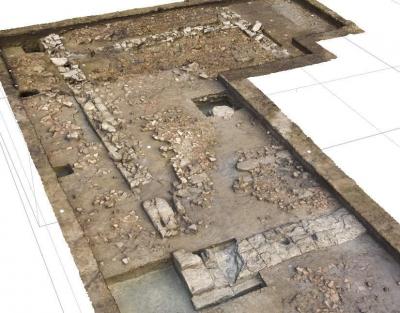 - Kleidi-Samikon - New excavations at Kleidi-Samikon in Greece’s Western Peloponnese show that the temple, discovered in 2022, is more monumental than previously assumed. In 2022, a team of archaeologists from the Austrian Archaeological Institute of the Austrian Academy of Sciences and the Ephorate of Antiquities of Elis of the Greek Ministry of Culture succeeded in uncovering a building that probably was located within the famous sanctuary of Poseidon and may even be identified as a temple of the sea god and earthshaker. As described by the ancient author Strabo, it is located near the sea below the ancient fortress of Samikon. It is a large 28-meter-long structure from the 6th century BC that was remodeled in the second half of the 4th century BC. The current discoveries provide further evidence that this temple was a cult building within the famous sanctuary of Poseidon, which was an important religious center in the region. During the excavations in autumn 2023, more parts of the temple were uncovered. It became apparent that the dimensions are larger than the initial evaluation of the geophysical investigations had allowed to expect. What was initially interpreted as a vestibule turned out to be a second room. Overall, it is a building about 28 m long and more than 9 m wide consisting of two interior rooms, a vestibule and a rear hall or shrine. Birgitta Eder, archaeologist and head of the Athens branch of the Academy’s Austrian Archaeological Institute: “We are looking at an Archaic temple consisting of two main rooms. A central row of two columns, which we found in the first hall and which supported the large roof covered with tiles, belongs to this phase. We may assume that there were also such columns in the second room. In any case, the ground plan of the temple is unusual. So far we know of no comparable buildings.” The function of the two rooms is still unclear. Perhaps it was a double temple, in which two deities were worshipped, or it is two rooms one behind the other, one of which could have served as a meeting place for the amphictyony of the cities of the Triphylian region. This was a loose association of cities on a religious-cultural basis in order to protect and administer a sanctuary. The research also shows that the temple has two construction phases. Erofili-Iris Kolia, director of the Euphoria of Elis: “In the second half of the 4th or first half of the 3rd century BC, the Archaic temple from the 6th century BC was remodelled. In the process, the old roof tiles were evenly applied as a subfloor for the new floor. They served as insulation against groundwater and to stabilise the floor. Something that still works today. In those places where tiles are missing, the ground is damp and muddy.” These dates correspond to the finds of pottery, which can be assigned to the Archaic and Late Classical to Early Hellenistic periods. In the coming years, the team wants to find out more about the dimensions of the sanctuary. Here, the continuous cooperation with geoarchaeologists from the University of Mainz and geophysicists from the University of Kiel is of importance. The ancient author Strabo describes the Poseidon sanctuary as a “grove of wild olive trees”. Thus, the question remains exciting as to whether other temple buildings, altars, treasure houses, a processional route or treasuries for dedications are still hidden under the earth.
- Kleidi-Samikon - New excavations at Kleidi-Samikon in Greece’s Western Peloponnese show that the temple, discovered in 2022, is more monumental than previously assumed. In 2022, a team of archaeologists from the Austrian Archaeological Institute of the Austrian Academy of Sciences and the Ephorate of Antiquities of Elis of the Greek Ministry of Culture succeeded in uncovering a building that probably was located within the famous sanctuary of Poseidon and may even be identified as a temple of the sea god and earthshaker. As described by the ancient author Strabo, it is located near the sea below the ancient fortress of Samikon. It is a large 28-meter-long structure from the 6th century BC that was remodeled in the second half of the 4th century BC. The current discoveries provide further evidence that this temple was a cult building within the famous sanctuary of Poseidon, which was an important religious center in the region. During the excavations in autumn 2023, more parts of the temple were uncovered. It became apparent that the dimensions are larger than the initial evaluation of the geophysical investigations had allowed to expect. What was initially interpreted as a vestibule turned out to be a second room. Overall, it is a building about 28 m long and more than 9 m wide consisting of two interior rooms, a vestibule and a rear hall or shrine. Birgitta Eder, archaeologist and head of the Athens branch of the Academy’s Austrian Archaeological Institute: “We are looking at an Archaic temple consisting of two main rooms. A central row of two columns, which we found in the first hall and which supported the large roof covered with tiles, belongs to this phase. We may assume that there were also such columns in the second room. In any case, the ground plan of the temple is unusual. So far we know of no comparable buildings.” The function of the two rooms is still unclear. Perhaps it was a double temple, in which two deities were worshipped, or it is two rooms one behind the other, one of which could have served as a meeting place for the amphictyony of the cities of the Triphylian region. This was a loose association of cities on a religious-cultural basis in order to protect and administer a sanctuary. The research also shows that the temple has two construction phases. Erofili-Iris Kolia, director of the Euphoria of Elis: “In the second half of the 4th or first half of the 3rd century BC, the Archaic temple from the 6th century BC was remodelled. In the process, the old roof tiles were evenly applied as a subfloor for the new floor. They served as insulation against groundwater and to stabilise the floor. Something that still works today. In those places where tiles are missing, the ground is damp and muddy.” These dates correspond to the finds of pottery, which can be assigned to the Archaic and Late Classical to Early Hellenistic periods. In the coming years, the team wants to find out more about the dimensions of the sanctuary. Here, the continuous cooperation with geoarchaeologists from the University of Mainz and geophysicists from the University of Kiel is of importance. The ancient author Strabo describes the Poseidon sanctuary as a “grove of wild olive trees”. Thus, the question remains exciting as to whether other temple buildings, altars, treasure houses, a processional route or treasuries for dedications are still hidden under the earth.
https://arkeonews.net/poseidon-temple-in-greece-larger-than-previously-assumed/
MEXIQUE –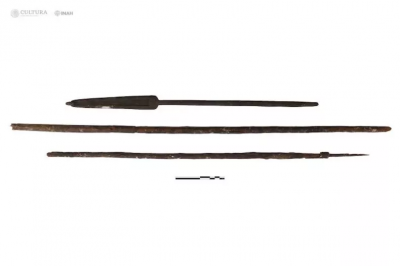 Cadereyta de Montes - Archaeologists from the National Institute of Anthropology and History (INAH) found hunting weapons dating back approximately 1,900 years in a cave in the central state of Querétaro. The Federal Ministry of Culture, in collaboration with the National Institute of Anthropology and History (INAH), recovered one of the few sets of pre-Hispanic hunting tools discovered in Mexico to date in a small gallery of the Cave of Treasure in Cadereyta de Montes, Querétaro. It consists of an atlatl (spear) and two wooden darts from the first century of our era. The cave is situated 200 meters above the ravine floor, and once at its entrance, researchers ventured 200 meters through a narrow passage to reach the gallery. Within this underground branch, with an average height of 80 centimeters, specialists observed an atlatl (51.5 centimeters long), two fragmented darts (66 and 79 centimeters), and a pair of culturally modified wooden sticks (135 and 172 centimeters), likely used as digging sticks and multifunctional tools. The atlatl is a spear-throwing lever that significantly increases the range and velocity of thrown projectiles, making it possible to target prey at a greater distance than with bare-handed throwing. The dryness of the environment in the Treasure Cave allowed for the preservation of the hunting instruments, the age of which was determined using radiocarbon dating techniques. This gave a possible age range of A.D. 7-132. During the exploration, the INAH team did not find other pre-Hispanic archaeological elements in the cave to provide an interpretation of why they were present in that remote location. However, the results of a sample analysis will be announced by the team on the 27th of January 2024. The INAH archaeologists said the mystery of the latest discoveries will persist until new investigations are carried out in the areas surrounding the cave. This may enable experts to determine how and why these instruments were left there.
Cadereyta de Montes - Archaeologists from the National Institute of Anthropology and History (INAH) found hunting weapons dating back approximately 1,900 years in a cave in the central state of Querétaro. The Federal Ministry of Culture, in collaboration with the National Institute of Anthropology and History (INAH), recovered one of the few sets of pre-Hispanic hunting tools discovered in Mexico to date in a small gallery of the Cave of Treasure in Cadereyta de Montes, Querétaro. It consists of an atlatl (spear) and two wooden darts from the first century of our era. The cave is situated 200 meters above the ravine floor, and once at its entrance, researchers ventured 200 meters through a narrow passage to reach the gallery. Within this underground branch, with an average height of 80 centimeters, specialists observed an atlatl (51.5 centimeters long), two fragmented darts (66 and 79 centimeters), and a pair of culturally modified wooden sticks (135 and 172 centimeters), likely used as digging sticks and multifunctional tools. The atlatl is a spear-throwing lever that significantly increases the range and velocity of thrown projectiles, making it possible to target prey at a greater distance than with bare-handed throwing. The dryness of the environment in the Treasure Cave allowed for the preservation of the hunting instruments, the age of which was determined using radiocarbon dating techniques. This gave a possible age range of A.D. 7-132. During the exploration, the INAH team did not find other pre-Hispanic archaeological elements in the cave to provide an interpretation of why they were present in that remote location. However, the results of a sample analysis will be announced by the team on the 27th of January 2024. The INAH archaeologists said the mystery of the latest discoveries will persist until new investigations are carried out in the areas surrounding the cave. This may enable experts to determine how and why these instruments were left there.
https://arkeonews.net/hunting-tools-dating-back-1900-years-found-inside-a-cave-in-queretaro-mexico/
GUATEMALA – 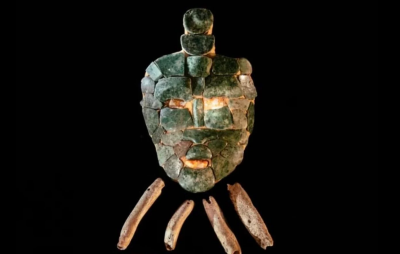 Peten, - Archaeologists excavating a looted pyramid tomb in the ruins of a Mayan city in Peten, northeast Guatemala, have discovered a mysterious interlocking jade mask believed to have belonged to a previously unknown Mayan king. Chochkitam, a little-known archaeological site, is located near the Peten Basin, a subregion of the Maya Lowlands in northwest Guatemala. The area is considered the heartland of the Maya Classic Period, which lasted from 200 to 900 AD. The site was first reported in 1909, and ongoing studies have revealed three major monumental groups linked by a long central causeway. In ancient times, the value of jade went far beyond its material value. Mayans considered it a protector of generations, living and dead. For this reason, jade masks were generally used to symbolize deities or ancestors, and were used to reflect the affluence and influence of the entombed individuals. Archaeologists discovered that grave robbers had excavated a tunnel into a royal pyramid’s core following a LiDAR survey in 2021. Further inspection revealed that the intruders had overlooked a specific area within the pyramid’s inner chamber. A human skull, and bones, some of them carved with hieroglyphs, a coffin-shaped stone box, ceramic artifacts, and funerary offerings including a pot, oyster shells, and multiple jade pieces that fit together to create a jade mask were found as a result of this oversight. The name Itzam Kokaj Bahlam is spelled out in carvings and hieroglyphs on some of the bone fragments. The researchers surmise that this name may belong to the buried Maya king who ruled Chochkitam approximately 350 AD. The most fascinating feature of all is that a carving on one of the bones shows the ruler clutching the head of a Maya deity, precisely like the assembled jade mask. All the artifacts and bones discovered in the Chochkitam tomb were brought to the Holmul Archaeological Project (HAP) lab for cleaning and field analysis. It was there that archaeologists put together the single blocks of jade that they had unearthed, and they were able to reconstruct an entire jade mosaic mask. Lead archaeologist Francisco Estrada-Belli of Tulane University and his team discovered the burial using LIDAR mapping technology, according to an extensive article in National Geographic. The mask represents a manifestation of the Storm God worshiped by the Mayans.
Peten, - Archaeologists excavating a looted pyramid tomb in the ruins of a Mayan city in Peten, northeast Guatemala, have discovered a mysterious interlocking jade mask believed to have belonged to a previously unknown Mayan king. Chochkitam, a little-known archaeological site, is located near the Peten Basin, a subregion of the Maya Lowlands in northwest Guatemala. The area is considered the heartland of the Maya Classic Period, which lasted from 200 to 900 AD. The site was first reported in 1909, and ongoing studies have revealed three major monumental groups linked by a long central causeway. In ancient times, the value of jade went far beyond its material value. Mayans considered it a protector of generations, living and dead. For this reason, jade masks were generally used to symbolize deities or ancestors, and were used to reflect the affluence and influence of the entombed individuals. Archaeologists discovered that grave robbers had excavated a tunnel into a royal pyramid’s core following a LiDAR survey in 2021. Further inspection revealed that the intruders had overlooked a specific area within the pyramid’s inner chamber. A human skull, and bones, some of them carved with hieroglyphs, a coffin-shaped stone box, ceramic artifacts, and funerary offerings including a pot, oyster shells, and multiple jade pieces that fit together to create a jade mask were found as a result of this oversight. The name Itzam Kokaj Bahlam is spelled out in carvings and hieroglyphs on some of the bone fragments. The researchers surmise that this name may belong to the buried Maya king who ruled Chochkitam approximately 350 AD. The most fascinating feature of all is that a carving on one of the bones shows the ruler clutching the head of a Maya deity, precisely like the assembled jade mask. All the artifacts and bones discovered in the Chochkitam tomb were brought to the Holmul Archaeological Project (HAP) lab for cleaning and field analysis. It was there that archaeologists put together the single blocks of jade that they had unearthed, and they were able to reconstruct an entire jade mosaic mask. Lead archaeologist Francisco Estrada-Belli of Tulane University and his team discovered the burial using LIDAR mapping technology, according to an extensive article in National Geographic. The mask represents a manifestation of the Storm God worshiped by the Mayans.
https://arkeonews.net/a-stunning-jade-mask-discovered-in-tomb-of-maya-king-in-guatemala/
ANGLETERRE – Northumberland - A study by the University of York has revealed that a tsunami wiped out prehistoric communities living in Northumberland, England, causing wide-scale depopulation across the region. According to the study, published in the Journal of Quarternary Science, a huge tsunami with 20 metre tall waves hit Britain’s coastline and parts of Europe during the Mesolithic period around 8,000-years-ago. The tsunami was likely caused by a large submarine landslide known as the Storegga slide, displacing 2400–3200 km3 of sediment off the coast of Western Norway. Traces of sediment deposits attributed to the event have been found in Northern England, Western Scotland, Shetland, Denmark, and as far as Eastern Greenland. Dr Jon Hill, an environmental scientist at the University of York, said: “A giant tsunami of this size would have devastated Stone Age coastal communities as it occurred in the autumn when they would have been gathering resources for the winter. The scale of the waves coming in would have been completely different to anything experienced by the people living there – a truly terrifying experience.” Archaeological evidence indicates a drop in settlement density across NW Europe during this period, which the study suggests was the result of the tsunami and not the previously held narrative of a rapid temperature drop across the continent. Dr Hill added: “Some past fishing societies in tsunami-prone regions such as the northern Pacific have shown some resilience to tsunamis and knew about moving to higher ground. But, the tsunami event in northern Britain was more of a freak event, with Stone Age people here having no living memory or ancestral knowledge about how to make themselves safe.” Computer simulations of the tsunami event were also created to determine whether the high waves could have contributed to population declines. Based on the simulation, researchers suspect there could have been significant mortality due to the tsunami as well as indirect impacts caused by damage to key resources that the ancient people needed to survive. Dr Hill said: “Alongside the direct mortality from the waves, this tsunami created longer-term impacts on resources for Stone Age people. It would have decimated food supplies so there’s a strong possibility this contributed to the sharp population decline we saw in northern Britain at this time, although this period also saw a rapid sea-level rise and a sharp drop in global temperatures.”




